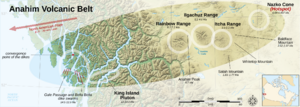King Island Pluton facts for kids

The King Island Pluton is a huge block of cooled magma found deep underground. It formed a long, long time ago, during a period called the Miocene epoch. This was about 23 to 5.3 million years ago! You can find it on the Central Coast of British Columbia, Canada.
This rock formation is very large. It stretches over 20 km (12 mi) (about 12 miles) long and 2.5 km (1.6 mi) (about 1.5 miles) wide. It goes from King Island all the way to the mainland. You can see parts of it in tall cliffs, up to 1,000 m (3,300 ft) (about 3,300 feet) high, along the Dean and Burke channels. These channels are west of a town called Bella Coola.
What is the King Island Pluton?
A pluton is a large body of igneous rock. This means it formed when molten rock, called magma, cooled and hardened deep inside the Earth's crust. The King Island Pluton is made of two main types of rock: syenite and alkali granite. These are both types of igneous rock, which are rocks formed from magma.
How it Formed
Scientists believe the King Island Pluton was once a magma chamber. A magma chamber is like a giant underground pool of molten rock. This chamber fed volcanoes that were active on the surface. Over millions of years, the volcanoes and the rock above the magma chamber wore away due to erosion. Erosion is when wind, water, and ice slowly break down and carry away rocks.
As the land above it eroded, the hard rock of the pluton became exposed. This is why we can see it today in the tall cliffs. When it first formed, this pluton was about 2 to 5 km (1.2 to 3.1 mi) (1.2 to 3 miles) below the Earth's surface.
Connection to Volcanoes
The King Island Pluton is very similar in its rock makeup to the shield volcanoes found in the central Anahim Volcanic Belt. The Anahim Volcanic Belt is a long chain of volcanoes in British Columbia. Because of these similarities, experts think the King Island Pluton was the source of magma for some of these ancient volcanoes. It's like finding the root system of a giant, ancient tree!

